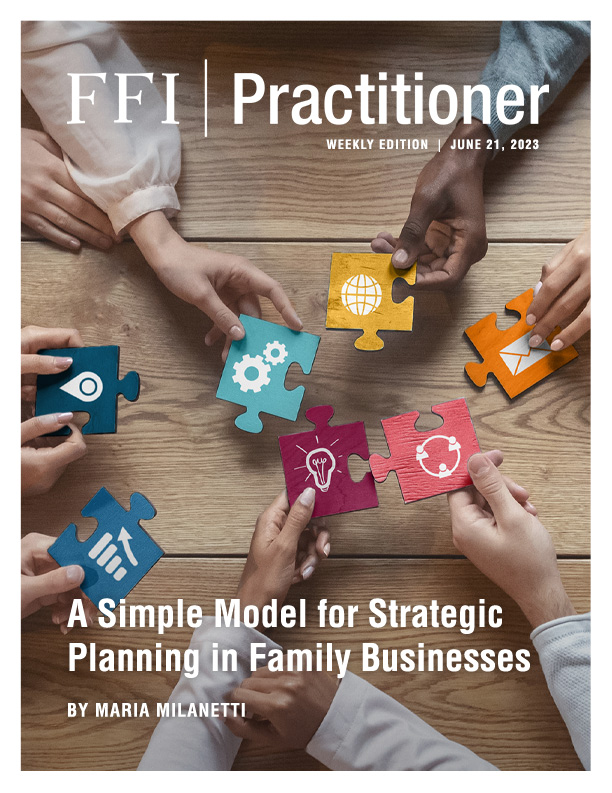
– John L. Ward
Ward’s research helps to show that many owners seemed to lack a conceptual framework to be able to assess their company and plan for its future. If, however, they embrace the idea of strategic planning, his research shows us that the owners were better able to renew and regenerate their businesses.
Family enterprise practitioners and owners typically recognize that first-generation family businesses, often started by the classic entrepreneurial “founder” personality, generally tend to grow organically and according to the founder’s interests and strengths.
The results of Ward’s study may also reflect the belief by founders that long-term planning for the business and its ownership can be too formal and inflexible. It often isn’t until leadership transitions to the second generation that we find a greater interest in more structured strategic planning. In some cases, it is not until the third generation that the family and the business embrace such planning.
Through my work with enterprising families, I have noticed several factors that help to promote strategic planning in an early generation family business. One factor is if the founder has come from a background in large organizations, where planning is more the norm. Another factor is if the founder or second generation have a background, training, or education in business strategy. These two groups seem much more open to the idea of strategic planning and are therefore willing to take the time to work “on the business” as well as “in the business” in a meaningful way.
Suggestions for a practical approach to strategic planning
Family business owners often want a simple and understandable model for strategic planning, to make efficient use of the limited time available to work on their businesses. To match this need for expediency, I have simplified this planning model over time and taken lessons from other industries.
This model starts with the goal for business owners to come out of the planning process with three to four large priorities (these are the main areas of emphasis for the business as a whole) and two to three enablers (these relate to the core structure of the business and how the identified priorities will be implemented). This format is designed to be easily understandable and accessible to all. To illustrate, below is an example of this approach.
Sidebar

by Rochelle Mendelsohn
According to Mark Twain, “The secret of getting ahead is getting started.” In that light, Rochelle Mendelsohn shares an article that explores the reasons why family enterprises without a strategic plan should consider developing their first and outlines seven tips for advisors working with these organizations throughout the process.
- Sales and Business Development or Customer Attraction
- IT and Technology
- Building Culture and Strategy
- Succession Planning
- The Finance Department
- Human Resources/People Practices
- Quality and Process Enhancement

Additional considerations for family enterprise strategic planning
Of course, there is always the need for “setting the table” before any structured planning can happen.
Ward refers to the following four questions in his 1988 article. It is just as important now as it was then to spend sufficient time with the family to help them to understand and develop family alignment around the answers to each:
- Why is the family committed to continuing the business?
- How does the family see itself and the company in the years ahead?
- How will the family build or maintain strong relationships, including things like competition with one another in the business?
- What steps are specific steps to accomplish the family’s professional and personal goals?
When working with a family enterprise client to develop a strategic plan, it is important to involve family leaders and key members of the business’ leadership team in the process, so the entire enterprise owns and can effectively implement the central plan within the business.
Why are we here and what do we value?
What is the external landscape like for the company?
How can we grow and win business?
How do we know we have gotten there?
Why are we here and what do we value?
What is the external landscape like for the company?
How can we grow and win business?
How do we know we have gotten there?
References
Stavros, J., Cooperrider, D., & Kelley, D.L.. (2003, November). Strategic Inquiry Appreciative Intent: Inspiration to SOAR: A New Framework for Strategic Planning. AI Practitioner. It has since been updated. https://aipractitioner.com/product/ai-practitioner-november-2003/
Appreciative Intent: Inspiration to SOAR: A New Framework for Strategic Planning. AI Practitioner. It has since been updated. https://aipractitioner.com/product/ai-practitioner-november-2003/
Ward, J.L. (1988). The Special Role of Strategic Planning for Family Businesses. Family Business Review, 1(2). 105–117. https://doi.org/10.1111/j.1741-6248.1988.00105.x
Kotak, N. (2015, March 2). Strategic Planning: Demystifying the Complexity—A Guest Blog by Neha Kotak. MarchFifteen Consulting. http://www.marchfifteen.ca/strategic-planning-demystifying-the-complexity-a-guest-blog-by-neha-kotak/




